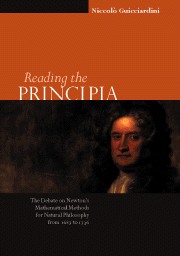 Reading the Principia
Reading the Principia Appendix
Published online by Cambridge University Press: 29 March 2010
Summary
Frontispiece from Isaac Newton's The method of fluxions and infinite series, London 1736. This work is an English translation of a Latin tract written by Newton in 1670–71. Colson, who held the Lucasian Chair of Mathematics in Cambridge from 1739 to 1760, added a long commentary in which he deals inter alia with foundational problems. This image expresses values that Newton was able to communicate to some of his followers. The figure refers to a problem solved on pages 267–76. Actually the bucolic scene is superimposed on a geometric diagram. Two points 1 (top) and 2 (lower) ‘flow’ from left to right along two straight trajectories. The motion of 1 is retarded, the speed of 2 is constant. The motion of a point 3 along the trajectory LMN, to be found, is such that at each instant the two points 1 and 2 must lie on the tangent at 3. This is a typical ‘inverse tangent problem’: a curve, to be found, is defined by the properties of its tangent. These problems lead to fluxional (or ‘differential’ equations). One of Colson's preferred ideas was that Newton's fluents and fluxions exist in nature (in Newton's words ‘Hae Geneses in rerum natura locum vere habent’ (Mathematical Papers, 8: 122–3)), while Leibniz's differentials are just fictions. According to Colson, the superiority of Newton's method over Leibniz's calculus – a point that Berkeley's Analyst (1734) would have missed – is that the fluxional symbols always refer to finite quantities which have an existence.
Information
- Type
- Chapter
- Information
- Reading the PrincipiaThe Debate on Newton's Mathematical Methods for Natural Philosophy from 1687 to 1736, pp. 263 - 264Publisher: Cambridge University PressPrint publication year: 1999